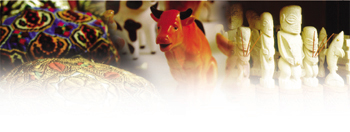The
Collecting Mania
>> What
is this thing we have about things? Is collecting a peculiarly
postmodern pastime? Or is collecting simply the madness that makes
humans human?

THE
HAND-LETTER SIGN outside the white clapboard shop reads,
"Antiques and Collectibles," and this is the late Friday
afternoon when you take the time to wonder both "just what
is a 'collectible'?" and "what isn't collectible?"
A collectible, after all, is anything that merits being bought
and brought home, doted upon, arranged and rearranged: not just
the souvenir plate from the 1933 World's Fair, the Eisenhower
pin, or the lava lamp, but also (apparently) the yellow rockers
rusting outside the shop, old fishing lures, a plastic cup from
Arby's. One person's junk is another person's prize-this is the
familiar and irrevocable law that enables the human species to
perform one of its most ambitious and least conscious modes of
recycling. That law itself depends, of course, on people's passion
for collecting things and on the creativity with which they confer
value on the myriad world of images and objects.
On
that same Friday you might sigh-who hasn't?-as you wonder about
the insanity with which people collect almost anything, almost
everything, these days: teeny Beanie Babies, beer bottles, Pasadena
postcards. The insanity may seem to be one mark of our postmodern
condition-in which even the immediate past becomes the object
of intense nostalgia, and in which the most banal acquisition
can get touted as a wise speculation. Collecting has become relentlessly
marketed: we're summoned and seduced by manufacturers (including
the U.S. Mint) to purchase figurines, commemorative plates, and
special-edition coins.
But
acts of collecting that cannot be reduced to the act of subscription-and
most cannot-comprise a more hardy and hybrid activity. On the
one hand, they generally depend on a form of consumption, but
a form in which the product is carefully preserved, not used or
used up; on the other, they are clearly acts of production, the
making of the collection per se, the creation of a certain order.
In an era when it is difficult to manifest one's individualism
through fashion (consumerism-as-usual) and when few Americans
are satisfied to define who they are through the daily work they
perform, collecting may serve as an especially satisfying mode
of self-definition. The "miracle of collecting," after
all, as Jean Baudrillard put in Le système des objets
(1968), is that "what you really collect is always yourself."
Whether your collection serves as a public display or as a private
preserve, it's a form of expression where you materialize that
abstract thing called the self, where you can thus see and handle
yourself, even talk to yourself, taking comfort in the way objects
stabilize you as a subject.
The
intensity of the collecting phenomenon, though, is hardly recent.
More than a century ago people were perplexed by what they termed
the "collecting mania," and that mania became an object
of serious censure, amused scrutiny, and scientific study. In
his Confessions of a Collector (1897), William Carew Hazlitt
(grandson of the literary critic), wrote of "that strange,
inexplicable cacoëthes" which "leads so many to
gather together objects of art and curiosities on no definite
principle or plea throughout their lives, to be scattered again
when they depart." Describing the hardships he endured to
support his book-buying habit, and imitating Thomas de Quincey's
"public exposure" of private "infirmity" in
the Confessions of an Opium Eater (1821), Hazlitt tells
the story of his augmenting bibliomania. Recognizing himself as
an addict, he considers collecting an addiction. But he also considers
it "an inborn and indestructible human trait." Call
it the madness that makes humans human.
Queen
Victoria, more human than most on this score, bestowed many of
her voluminous collections upon what became known (in 1899) as
the Victoria and Albert Museum, even as her name was bestowed
on a sensibility that we've come to associate with excessive ornamentation
and obsessive accumulation-a sensibility determined to line the
mantel with bric-a-brac and to fill display cabinets with paperweights
and shells. By now, any student of U.S. history has confronted
the fact that even conscientious historians refer to the late-19th
century as "Victorian America": despite its political
freedom from England, the U.S. remained culturally at one with
the mother country-caught up, at least, in the same accumulating
passions, caught by the same fanaticism.
Indeed,
it was New York and not London that witnessed the birth of The
Curio in 1887, a new journal, richly illustrated, devoted
exclusively to collectors. The inaugural volume declared that,
"like all fanatics, whose life has but one object,"
the collector "deserves careful study" as well as "sound
advice." But the collector was not an easy character to bring
into focus, "for in truth, there is nothing that collectors
will not collect," and the collector had become less a recognizable
type than the population at large: "New York is now a city
of collectors, from Mr. Brayton Ives, who collects the first classics,
to the 'Doctor' who is a collector of pipes."
No
one doubted that previous eras-Imperial Rome, Golden Age Holland,
18th-century England-had witnessed remarkable efforts to gather
up the riches of the world. But they also sensed a new ubiquity
of less remarkable efforts, the simple pleasure of doggedly amassing
a world of objects distinctly one's own. By the turn of the century,
an Atlantic article on "The Tyranny of Things"
proclaimed that the "passion for accumulation is upon us":
we "make 'collections,' we fill our rooms, our walls, our
tables, our desks, with things, things, things." The inevitable
result of this passion-the quintessence of so-called Victorian
taste-was that society ended up "overwhelmed by the invading
host of things." Americans, it seemed, had become wholly
possessed by their possessions.

IN
THE CLOSING decades
of the 19th century, the most renowned American collectors-among
them J. Pierpont Morgan (1837-1913), Isabella Stewart Gardner
(1840-1924), and Henry Clay Frick (1849-1919)-brought the treasures
of Europe-rare manuscripts and books, Italian and Dutch paintings,
French furniture and tapestries-back to the cities of the United
States. Just as the Old World had considered the New World a vast
geographical field for imperial expansion, so the New World came
to consider the Old a vast cultural field for expropriation. Henry
James, the expatriated novelist who befriended more than a few
well-known collectors, didn't tire of the theme. In The American
(1877), Christopher Newman becomes "conscious of the
germ of the mania of the 'collector'" while in Paris. In
The Golden Bowl (1904), the incomparably astute Adam Verver
has amassed exquisite treasures with which he means to create
a "museum of museums" back in the States and thus to
demonstrate "civilization condensed, concrete, consummate."
His taste is hardly confined to inanimate works of art: as his
daughter Maggie explains to her fiancé, an Italian prince,
"You're a rarity, an object of beauty, an object of price….
You're what they call a morceau de musée."
If
the success of collecting depends, first off, on the act of objectification
(transforming a book, for instance, from a text into an artifact)
then successful collecting can suddenly veer toward thinking of
people as things. However scandalized we may be by such excess,
the distinction between people and things is inevitably blurred,
somewhat, when we collect things in order to conjure up the people
who possessed them. The idiosyncratic Henry Chapman Mercer (1856-1930),
who devoted much of his life to manufacturing Arts & Crafts
tile, turned Anglo-American culture into a source of anthropological
fascination by collecting thousands of 19th-century tools and
building a museum for them. He helped to inaugurate not just the
history of technology but also the study of everyday life.
Democratizing
the artifactual world, expanding the notion of what was worth
collecting and why, he argued that "these castaways"
offered "manifold elucidations of nationality" by "leading
us by way of an untrodden path, deeper into the lives of people…until
at last the heart is touched." The utensils weren't simply
objects; they were metonyms for the people who put them to use.
Such
a democracy of objects both enabled and mirrored a new democracy
of collecting subjects. On the one hand, as Neil Harris has shown
(in Cultural Exursions: Marketing Appetites and Cultural Tastes
in Modern America, 1990), there was an effort to define the
characteristics of the true collector. On the other, even the
home of the workman, as the economist Simon Patten put it, was
"crowded with tawdry, unmeaning, and useless objects,"
and these were "loved" as "the mark of superiority
and success," their "enjoyment energiz[ing] the possessor."
If we're to believe the commentary of the time, it was above all
two world's fairs, the Centennial Exposition in Philadelphia (1876)
and the Columbian Exposition in Chicago (1893) that fueled the
generalized passion for accumulation and display, just as the
Exposition at the Crystal Palace had done in London (1851).
The
Curio claimed that the taste for bric-a-brac began with the
Centennial Fair, as did the taste for what we now call Americana.
One writer noted that "everybody seems to be furbishing up
his ancestors and setting them on end, as it were, in company
with all the old tea-kettles, queue-ties, rusty muskets, snuff-boxes,
and paduasoys." Whether or not such writers were recording
a change in actual practice, they certainly were participating
in a change of perception: one need not be collecting the treasures
of Europe to have a collection worthy of the name.
As
"distinguished collectors" (Hazlitt's term) and collecting
institutions in America worked to refine their standards, less
august individuals seemed to loosen theirs. The Smithsonian-once
called the National Cabinet of Curiosities but renamed the U.S.
National Museum in 1876 (A
NATION OF THINGS)-believed that its new task of
developing a "nursery of living thoughts" meant eradicating
the "chance assemblage of curiosities" and discarding
the "cemetery of bric-à-brac." But that bric-a-brac,
arranged with utmost care atop the upright piano, could itself
be a nursery of thought.
Indeed,
if there is an overriding principle of private collecting, it
is that the collector, establishing a different order of things,
enjoys the fact or the fantasy of wresting authority away from
institutions and even from that thing we call "culture,"
establishing a different system of value and meaning. The collection
becomes the source of specialized knowledge-about Venetian glass,
or baseball cards, or swords, or Barbie dolls, or stamps. And
the collector can claim some mastery, some exhilarating expertise.
Collectors collect more than objects; they collect the knowledge
(however pedestrian or profound) that empowers them to take pleasure
in those objects and to take advantage of someone else's ignorance.
More than any mere consumer, the collector lives for the thrill
of the bargain because the bargain is the theatrical mark of a
knowledge both superior and secret.

THE
BARGAIN (no less, the act of bargaining) is just one
manifestation of the power dynamics intrinsic to the practice,
however casual or studied it may be. For pocketing the flat circular
stones along the beach amounts to dislocating the objects from
one environment and installing them in another. Preserving obsolete
gadgets disrupts the "law" of technological progress,
just as wearing vintage clothes disrupts the "law" of
fashion. Pressing leaves combats the natural law of decay. If,
as Baudrillard suggests, "the passionate pursuit of possession
finds fulfillment" in collecting, transforming the "everyday
prose of objects" into "poetry," this is an aggressive
and authoritarian poetry, a private mode of imperialism, a belligerent
act of recycling meant to insist that ephemera is not ephemeral.
Actual
emperors, of course, have been history's most famous collectors:
when Napoleon amassed his trophies of conquest in the Louvre (temporarily
renamed the Musée Napoleon in 1803) it became the world's
foremost museum. (And, as Susan A. Crane, AM'87, PhD'92, argues
in Collecting and Historical Consciousness in Early Nineteenth-Century
Germany [2000], collecting served as a way of inventing and
asserting a nationalist past in the face of the foreign aggressor.)
Other collectors flamboyantly behave like emperors. At the close
of Citizen Kane (1941), the camera slowly surveys the broken
packing crates in the cellar of Xanadu, the castle built by the
newspaper tycoon, an "emperor of new strength" who has
amassed not just Egyptian statues and Scottish mantels, but also
animals from Africa and Asia. In Orson Welles's fictionalized
account of William Randolph Hearst, this collecting mania serves
to fill up the emotional emptiness left by the absence of his
parents. In other words, the obsessive accumulation of objects
strives to compensate for everything he does not have. A manifestation
of power, it is nonetheless a symptom of powerlessness.
Welles
anticipates the perspective of Werner Muensterberger, who, in
Collecting: An Unruly Passion (1995), assumes that the
attachment to things always substitutes for an attachment to people:
a psychoanalyst, Muensterberger reads Balzac's craving for objects
as the craving for the parental affection he never had. At the
very least, collecting can be recognized as a physical attempt
to overcome a metaphysical dilemma, and thus a necessarily futile
endeavor that can only end up provoking the need for further acquisition.
At a more rudimentary level, though, psychologists think of children's
collecting habits as efforts to affirm some control over their
material environment. Even before psychology reached that conclusion,
when child psychology was just emerging as a field (under the
auspices of G. Stanley Hall in the 1880s), collecting was one
of its inaugural topics.
Specialists
concluded that-because "the mania seizes upon any and practically
every outlet imaginable," and because the activity is more
important than the content-one should not "hesitate in calling"
collecting "an instinct." Scientific surveys confirmed
Hazlitt's hunch.
An 1899 survey showed that most children had three or four collections
and that the instinct manifests itself in earnest at the age of
three, becoming most intense at the age of ten (a chronology that
more recent psychology has revised). As for the "question
as to what children collect," it was best "answered
by asking what they do not collect." The most popular items
among the many were birds' eggs, shells, bullets, stamps, marbles,
and, above all, cigar tags.
The
crucial point that emerged from such early studies was the way
that collecting enacts both imitation and individuation. By collecting
marbles you join a group; by collecting only cat's eyes, you differentiate
yourself within the group. In fact, something of the same dialectic
occurs at the level of the object: a new object is acquired because
it fits into the series but also because it doesn't replicate
an existing possession. Among both human subjects and inanimate
objects, then, the collector is all the while negotiating the
balance between generality and specificity, between the singular
and the type, the assertion of novelty and the capitulation to
the preestablished standard. Should you decide to walk into the
antique shop that Friday afternoon, simply following an impulse,
you'll be doing so more logically than you know.

BUT
LOGIC ALONE
cannot account for this "instinct," which seems to be
driven no less by a kind of magic, by an inexplicable vitality
that objects and images assert when they discover us discovering
them. Indeed, when you say that a collection really demands this
or that addition, you voice not the desire for objects,
but the desire of objects. You have begun to appreciate
what it is that objects want: they want you to mediate their relation
to other objects. You've begun to grant the objects something
of the status of a subject, with moods of their own, if not quite
strange fits of passion. You've begun to break down the all-too-reasonable
ontological distinction between human beings and the physical
world they inhabit.
Within
the archive of early child psychology, explanations of passion
often explain very little, but they offer impressive portraits
of fixation. One psychologist, blissfully unaware of the research
Freud had begun to pursue, wrote of one "boy's passion for
bottles, beginning in his first year as a fear and mystery,"
as "a fetich-feeling for a particular huge green bottle,
and developing into an affection for bottles in general and [the]
love of many bottles." What dangers do we risk when we translate
this love of bottles into a story of human relations, or when
we think of this intimacy as necessarily standing in for something
else? We risk not recognizing how the human enchantment with objects
(the enchantment of objects) seeks to transform them, seeks out
the thing that is in excess of the object and that can preserve
that object from the fate of mere use. Bottles become more than
bottles.
In
current discussions of collecting, Walter Benjamin (the German
theorist who developed the insights of Marx, Georg Simmel, and
Freud into a materialist phenomenology) enjoys a privileged status
because, as a passionate collector himself, he understood something
of this enchantment, and he fully recognized the emotional, historical,
and political stakes of the intensely private act of selecting
and preserving some object, which, in that moment of selection,
attains the status of an artifact. Whether it was the cultural
debris the surrealist poets found at flea markets, the hand-crafted
toys children played with, or the decorative ironwork of the 19th
century, Benjamin sensed in these physical objects the otherwise
suppressed longing for some alternative to the fate that history
has bestowed upon us.
As
for collectors, he thought of them as saving objects from the
"tyranny of use," on the one hand, and, on the other,
laboring at "the Sisyphean task of obliterating the commodity-like
character of things." In other words, the collector-or, for
Benjamin, the "real collector"-insists on investing
the object with a value that has nothing to do with "use
value" or "exchange value." It hardly could, since,
as he passionately explains in "Unpacking My Library,"
the point of acquiring an object is to renew it, to grant it freedom
within the "magic circle" of the collection, enabling
it to be something other than it was.
Writing
in 1931, Benjamin thought that the era of the private collector
had come to a close: public collections were supplanting private
ones. However thoroughly his Marxist sympathies made him recognize
this transition as social progress, he nonetheless insisted that
it is only in private collections "where objects get their
due," where ownership attains the quality of bliss, and where
the fate of the object is genuinely cherished. If in fact the
"real collector" is hard to find amid the crowd these
days, driven as it is by the most recent collecting mania, this
hardly means that the mania itself isn't unconsciously inspired
by some desire to give the objects of our world some other life.
If, when your eye lingers over the "antiques and collectibles,"
you discover an old snow globe and suddenly long to have it-all
but ache to arrange it alongside other globes, or other toys,
or other scenes of winter-that longing may be provoked by many
sources. You may want the snow globe because it reminds you of
the one in Citizen Kane or the one you dropped and shattered
as a child, or because Benjamin took such delight in snow globes.
What may be more important, though, is the way-when you pick up
the globe and watch the yellowed snow flurry and settle, flurry
and settle-that you see a secret world within objects, a world
that you yourself can bring to life.
Bill Brown, the George M. Pullman professor of English language
& literature, is also master of the Humanities Collegiate
Division and associate dean of Humanities. Author of The Material
Unconscious: American Amusement, Stephen Crane, and the Economies
of Play (1996), he is coeditor of the journal Critical
Inquiry and editor of its Fall 2001 special issue, "Things."
His forthcoming book, A Sense of Things: Literary Objects
in America, will be published by the University of Chicago
Press in 2002.


![]()



